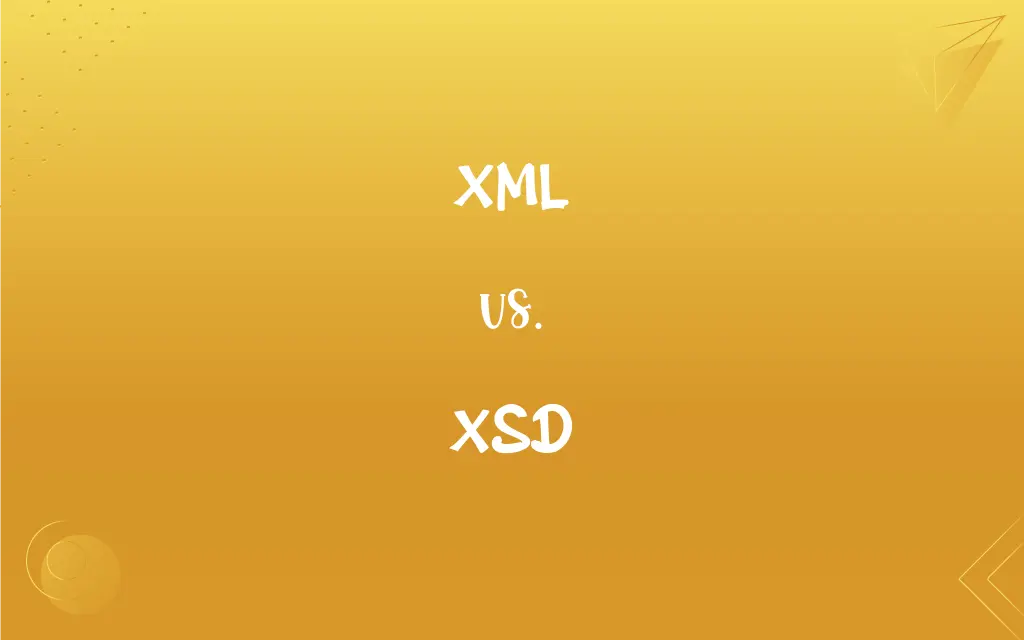XML vs. XSD: What's the Difference?
Edited by Aimie Carlson || By Janet White || Published on February 7, 2024
XML (eXtensible Markup Language) is a format for structuring data, while XSD (XML Schema Definition) is used to define the structure and data types in an XML document.

Key Differences
XML is a markup language used for encoding documents in a format that is both human-readable and machine-readable. It is flexible and customizable for various data representation needs. On the other hand, XSD is a schema language for XML, providing a set of rules to define the structure, content, and semantics of XML documents.
XML is primarily used for storing and transporting data, focusing on simplicity, generality, and usability across the Internet. XSD, in contrast, is used to validate the structure and content of XML data, ensuring that XML documents adhere to a predefined structure and type constraints.
XML provides a framework for describing data, it does not inherently enforce any semantic rules or data integrity. XSD fills this gap by allowing the creation of custom rules and structures that XML documents must follow, thus ensuring data consistency and validation.
XML and XSD are intrinsically linked; XML defines the data, while XSD defines the rules and constraints for the data in XML. XSD can be seen as a blueprint for what an XML document should look like, specifying which elements are allowed, and in what combination.
From a user's perspective, XML is about creating and reading data in a standardized format, while XSD is about ensuring that the data fits a specific schema, useful for data validation and quality assurance in XML document processing.
ADVERTISEMENT
Comparison Chart
Definition
Markup language for data structuring
Schema language for XML document validation
Primary Function
Data storage and transportation
Validation of XML document structure
Role in Data Handling
Describes data
Defines rules and constraints for data
Implementation
Lacks inherent data validation
Provides mechanism for data integrity
User Perspective
Used for creating and reading data
Ensures data adheres to a specific schema
ADVERTISEMENT
XML and XSD Definitions
XML
Standard for encoding documents in a format that can be read easily.
XML files store configuration settings for various software applications.
XSD
Provides a means to define the structure of XML data.
XSD ensures the XML document for patient records adheres to the hospital's data standards.
XML
Used for describing data with custom tags.
XML allows the creation of custom data structures for web services.
XSD
Ensures XML data adheres to a specific format and type.
XSD is crucial in standardizing XML document structures for inter-organizational data exchange.
XML
A flexible way to create common information formats.
XML is used to store and transport data like blog post content.
XSD
Used for validating the elements and attributes in XML documents.
XSD is used to validate the data format in the XML file for compatibility.
XML
Markup language designed to be both human- and machine-readable.
RSS feeds are formatted using XML for easy syndication.
XSD
Specifies rules for what an XML document should contain.
The company's product data XML is validated against a predefined XSD for consistency.
XML
Facilitates data sharing across different information systems.
XML is used for exchanging data between disparate systems in a healthcare network.
XSD
Acts as a blueprint for creating valid XML documents.
Developers use XSD to ensure XML files meet the application's requirements.
XML
An international standard metalanguage for creating markup languages that structure digital information in a way that allows for the exchange, display, and storage of data independent of proprietary operating systems and hardware devices.
FAQs
What does XSD stand for?
XSD stands for XML Schema Definition.
What is XML primarily used for?
XML is used for structuring, storing, and transporting data.
What is the main benefit of using XSD?
The main benefit of XSD is ensuring the correct structure and data types in XML documents.
Is XML human-readable?
Yes, one of the advantages of XML is its human-readable format.
Does XSD allow specifying mandatory and optional elements?
Yes, XSD allows defining elements as mandatory or optional in XML documents.
Is XSD necessary for XML?
XSD is not necessary but is important for validating XML data structures.
How does XML improve data interchange?
XML provides a standard format for data exchange across different systems.
How does XML facilitate data sharing?
XML standardizes the way data is structured, making it easier to share across different systems.
Can XML be used without XSD?
Yes, XML can be used without XSD, but without validation of structure.
Can XML be used for web development?
Yes, XML is widely used in web development for data representation.
What are the limitations of XML?
XML can be verbose and may result in larger file sizes compared to other formats.
What makes XML versatile?
XML's customizability and its ability to work across platforms make it versatile.
Does XSD support data types validation?
Yes, XSD supports validation of various data types in XML documents.
Is XSD used for data integrity?
Yes, XSD is used to maintain data integrity in XML documents.
Are XML and XSD compatible with all programming languages?
XML and XSD are widely compatible with many programming languages, as they are standards for data representation and validation.
Are there any specific software tools for XML?
Yes, there are various XML editors and parsers available for working with XML.
Is learning XSD complex?
XSD can be complex due to its detailed structure and rules, but it's manageable with practice.
Can XSD define custom data structures?
Yes, XSD can be used to define custom data structures for XML.
Can XSD impose order on elements in XML?
Yes, XSD can specify the order in which elements must appear in XML.
Can XML handle multimedia data?
XML can reference multimedia data but is primarily suited for text-based data structuring.
About Author
Written by
Janet WhiteJanet White has been an esteemed writer and blogger for Difference Wiki. Holding a Master's degree in Science and Medical Journalism from the prestigious Boston University, she has consistently demonstrated her expertise and passion for her field. When she's not immersed in her work, Janet relishes her time exercising, delving into a good book, and cherishing moments with friends and family.
Edited by
Aimie CarlsonAimie Carlson, holding a master's degree in English literature, is a fervent English language enthusiast. She lends her writing talents to Difference Wiki, a prominent website that specializes in comparisons, offering readers insightful analyses that both captivate and inform.






































































